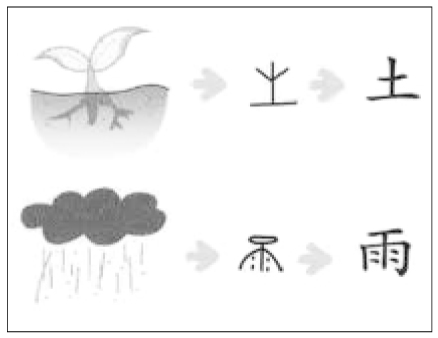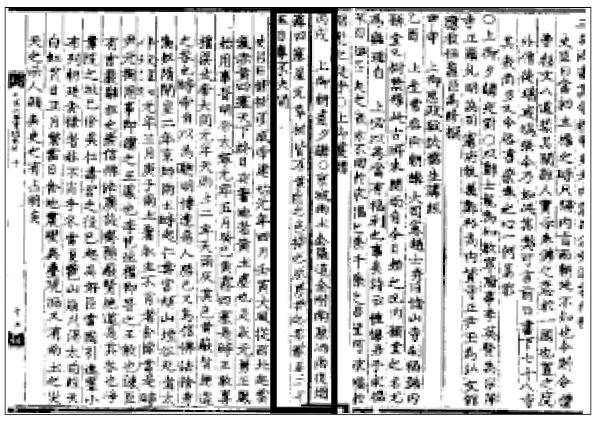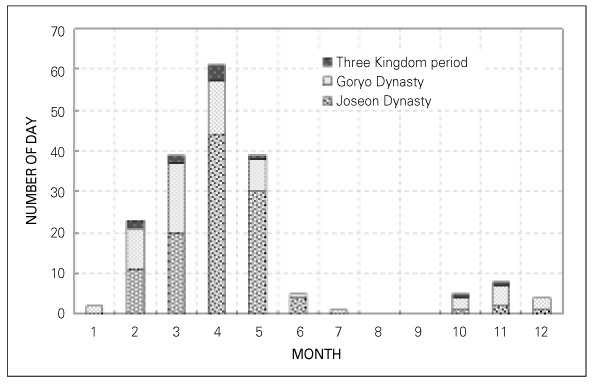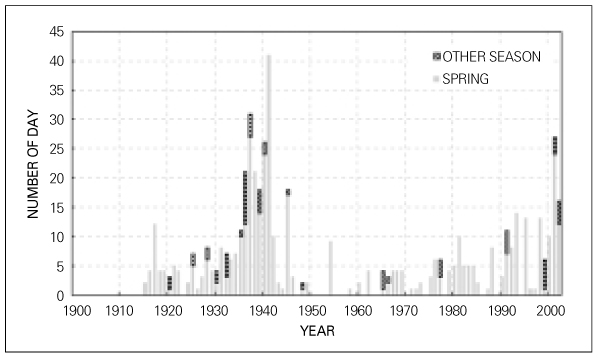J Korean Med Assoc.
2004 May;47(5):446-452. 10.5124/jkma.2004.47.5.446.
From Historical Dust ail to Early Warning of Asian Dust Events in Korea
- Affiliations
-
- 1Meteorological Research Institute, Korea. yschun@metri.re.kr
- KMID: 2137880
- DOI: http://doi.org/10.5124/jkma.2004.47.5.446
Abstract
- Asian dust is the windblown dust, frequently originating from the Sand desert, Gobi desert, and Loess plateau in Northern China and Mongolia during the spring season. This dust phenomenon is called as "Hwangsa" in Korea meaning yellow sand. Dust can be lifted into the middle troposphere by strong winds in the source regions. In this article, we will overview the historical records of Hwangsa and Early warning of Hwangsa in Korea. The symbolic word "Woo-Tou" was used to describe dust phenomenon, which was defined as a descending substance in the atmosphere other than water droplets. During that period we believed dust as an impetuous order toward king from God. Why dust falls from the sky? Did I do something wrong? The time when we reflected ourselves with modest mind. That was our image 100 years ago. Now Hwangsa is treated as a part of natural phenomena. Hwangsa flew from dried area such as China and Mongolia to Korean peninsular and appears as in yellow color. Particularly, human being's inappropriate management on earth soil makes origin area of Hwangsa to be expanded. Hwangsa, which occurs by overlapping of natural phenomena and artificial factors, causes various problems. To deal successfully with Hwangsa, we should cooperate with each other and expect peace in northeast Asia.
Keyword
MeSH Terms
Figure
Cited by 2 articles
-
Toxicity and health effects of Asian dust: a literature review
Ho-Jang Kwon
J Korean Med Assoc. 2012;55(3):234-242. doi: 10.5124/jkma.2012.55.3.234.Toxicity and health effects of Asian dust: a literature review
Ho-Jang Kwon
J Korean Med Assoc. 2012;55(3):234-242. doi: 10.5124/jkma.2012.55.3.234.
Reference
-
1. Husar RB, Tratt DM, Schichtel BA, Falke SR, Li F, Malm WC, et al. Asian dust events of April 1998. Journal of Geophysical Research. 2001. 106:18137–18133.
Article2. McKendry IG, Hacker JP, Stull R, Sakiyama S, Mignacca D, Reid K. Long-range transport of Asian dust to the lower Fraser Valley, British Columbia, Canada. Journal of Geophysical Research. 2001. 106:18361–18370.
Article3. Qian Weihong, Zhu Y. Climate change in China from 1880 to 1998 and its impact on the environmental condition. Climate Change. 2001. 50:419–414.5. Quan H. KOSA study in the 3000 years. Research of Environmental Sciences. 1994. 7,6:1–12. in Chinese.6. Tamura S. A study on the Meteorological Research in Joseon. 1983. 399. In Japanese.
Article7. UNEP. The North American Dust Bowl and Desertification: Economic and Environmental Interactions. World Atlas of Desertification. 1997. 2nd ed. 149–154.8. Wada Y. Dust phenomenon in Korea. Reports on the historical recording of Joseon, Joseon Chongdokbu. 1917. 106–143. in Japanese.
- Full Text Links
- Actions
-
Cited
- CITED
-
- Close
- Share
- Similar articles
-
- Toxicity and health effects of Asian dust: a literature review
- The Health Effects of Asian Dust Event
- A Study on the Size of Dust in Workplaces of a Shipyard
- Effect of the Asian Dust Events on Respiratory Disease During the Spring
- Effects of the Severe Asian Dust Events on Daily Mortality during the Spring of 2002, in Seoul, Korea









